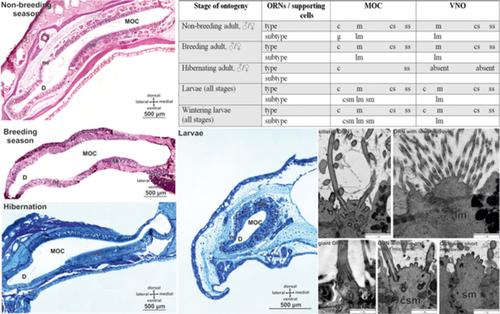当前位置:
X-MOL 学术
›
J. Morphol.
›
论文详情
Our official English website, www.x-mol.net, welcomes your feedback! (Note: you will need to create a separate account there.)
Macro‐ and micromorphological remodeling of olfactory organs throughout the ontogeny of the fire salamander Salamandra salamandra (Linnaeus, 1758)
Journal of Morphology ( IF 1.5 ) Pub Date : 2020-08-17 , DOI: 10.1002/jmor.21239 Józef J Różański 1 , Krystyna D Żuwała 1
Journal of Morphology ( IF 1.5 ) Pub Date : 2020-08-17 , DOI: 10.1002/jmor.21239 Józef J Różański 1 , Krystyna D Żuwała 1
Affiliation

|
This article studies the morphological remodeling of olfactory organs in the fire salamander (Salamandridae, Caudata), from the larval stages of ontogeny to the adult and throughout the course of the annual cycle. The fire salamander exhibits adaptations to the aquatic environment during premetamorphic life and terrestrial adaptations after metamorphosis. During adulthood, the annual activity of this species is divided into three seasonal periods: a breeding period, a nonbreeding period, and hibernation. We observed significant differences in morphology of olfactory organs between developmental stages as well as between each period within the annual cycle. For the first time in caudates, we examined the morphology of olfactory organs during the winter period (wintering larvae, hibernating adults). The results show that the remodeling of olfactory organs during the life of the fire salamander occurs both on macro‐ and micromorphological levels. Macromorphological ontogenetic variability includes the shape of the main olfactory chamber (MOC) and the distribution of olfactory epithelium (OE) in the MOC and in the vomeronasal organ (VNO). In larvae, the vomeronasal epithelium (VNE) is in a separate cavity, while in the post‐metamorphic stages of ontogeny, the VNE occurs in the diverticulum of the MOC. In adult fire salamanders, both olfactory organs are most developed during the breeding season and reduced during hibernation. The VNE and OE in the MOC are also reduced during hibernation. Micro‐morphological changes included different types/subtypes of olfactory receptor neurons (ORNs) in the OE in particular stages of ontogeny and periods within the annual cycle, for example, ciliate ORNs are present in the VNE only in the larval stages and giant ORNs occur only in nonbreeding adults. Also, there was a variable set of types of olfactory supporting cells in the VNO of the fire salamander during pre‐ and postmetamorphic life stages.
中文翻译:

整个火蝾螈个体发育过程中嗅觉器官的宏观和微观形态重塑 (Linnaeus, 1758)
本文研究了火蝾螈(Salamandridae,Caudata)嗅觉器官的形态重塑,从个体发育的幼虫阶段到成虫,以及整个年度周期的过程。火蝾螈在变态前的生活和变态后的陆地适应期间表现出对水生环境的适应。在成年期,该物种的年度活动分为三个季节性时期:繁殖期、非繁殖期和冬眠期。我们观察到发育阶段之间以及年度周期内每个时期之间嗅觉器官形态的显着差异。我们第一次在尾状体中检查了冬季(越冬幼虫、冬眠成虫)嗅觉器官的形态。结果表明,火蝾螈一生中嗅觉器官的重塑发生在宏观和微观两个层面。宏观个体发育变异性包括主嗅室 (MOC) 的形状和嗅觉上皮 (OE) 在 MOC 和犁鼻器官 (VNO) 中的分布。在幼虫中,犁鼻上皮 (VNE) 位于单独的腔中,而在个体发育的后变质阶段,VNE 发生在 MOC 的憩室中。在成年火蝾螈中,两个嗅觉器官在繁殖季节最为发达,而在冬眠期间则减弱。MOC 中的 VNE 和 OE 在休眠期间也会减少。微形态变化包括在个体发育的特定阶段和一年周期内的 OE 中嗅觉受体神经元 (ORNs) 的不同类型/亚型,例如,纤毛虫 ORNs 仅在幼虫阶段存在于 VNE 中,而巨型 ORNs 出现仅在非繁殖成年人中。此外,在变质前和变质后的生命阶段,火蝾螈的 VNO 中存在一组可变类型的嗅觉支持细胞。
更新日期:2020-08-17
中文翻译:

整个火蝾螈个体发育过程中嗅觉器官的宏观和微观形态重塑 (Linnaeus, 1758)
本文研究了火蝾螈(Salamandridae,Caudata)嗅觉器官的形态重塑,从个体发育的幼虫阶段到成虫,以及整个年度周期的过程。火蝾螈在变态前的生活和变态后的陆地适应期间表现出对水生环境的适应。在成年期,该物种的年度活动分为三个季节性时期:繁殖期、非繁殖期和冬眠期。我们观察到发育阶段之间以及年度周期内每个时期之间嗅觉器官形态的显着差异。我们第一次在尾状体中检查了冬季(越冬幼虫、冬眠成虫)嗅觉器官的形态。结果表明,火蝾螈一生中嗅觉器官的重塑发生在宏观和微观两个层面。宏观个体发育变异性包括主嗅室 (MOC) 的形状和嗅觉上皮 (OE) 在 MOC 和犁鼻器官 (VNO) 中的分布。在幼虫中,犁鼻上皮 (VNE) 位于单独的腔中,而在个体发育的后变质阶段,VNE 发生在 MOC 的憩室中。在成年火蝾螈中,两个嗅觉器官在繁殖季节最为发达,而在冬眠期间则减弱。MOC 中的 VNE 和 OE 在休眠期间也会减少。微形态变化包括在个体发育的特定阶段和一年周期内的 OE 中嗅觉受体神经元 (ORNs) 的不同类型/亚型,例如,纤毛虫 ORNs 仅在幼虫阶段存在于 VNE 中,而巨型 ORNs 出现仅在非繁殖成年人中。此外,在变质前和变质后的生命阶段,火蝾螈的 VNO 中存在一组可变类型的嗅觉支持细胞。


























 京公网安备 11010802027423号
京公网安备 11010802027423号